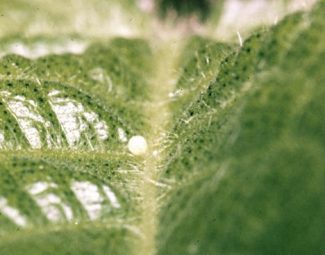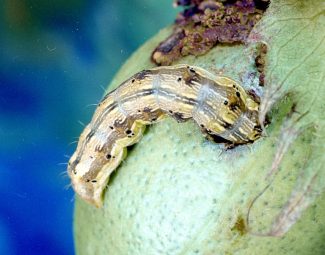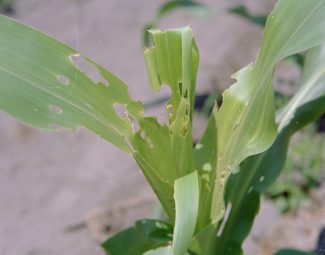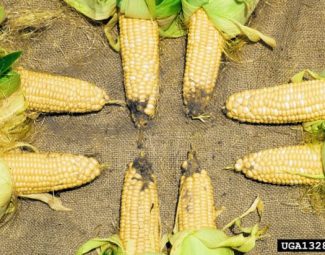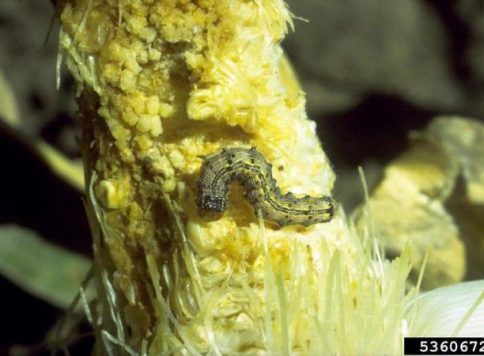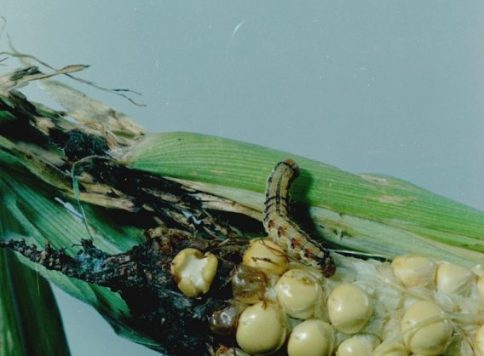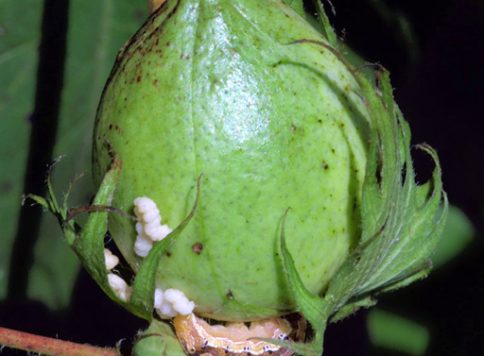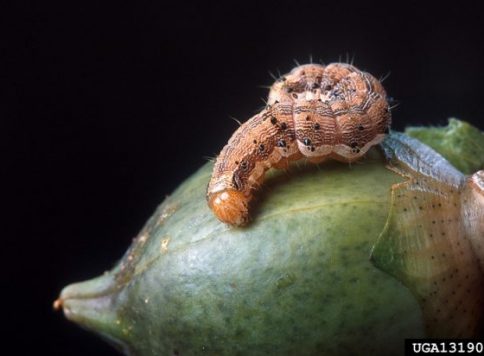Cotton Bollworm
Insect Summary Report
Also known as CORN EARWORM
Helicoverpa zea
General Information
- Cotton Bollworm is known by many other common names: corn earworm, tomato fruitworm, vetchworm, sorghum headworm and soybean podworm are a few.
- Very similar to tobacco budworm (Heliothis virescens) in both appearance and life cycle. Commonly grouped together for control recommendation purposes.
- Has a broad host range that includes: artichoke, asparagus, cabbage, cantaloupe, collard, cowpea, cucumber, eggplant, lettuce, lima bean, melon, okra, pea, pepper, potato, pumpkin, snap bean, spinach, squash, sweet potato, alfalfa, clover, cotton, flax, oat, millet, rice, sorghum, soybean, sugarcane, sunflower, tobacco, vetch, avocado, grape, peaches, pear, plum, raspberry, strawberry, carnation, geranium, gladiolus, nasturtium, rose, snapdragon, zinnia, wheat and watermelon.
- Corn, tomato and sorghum appear to be most preferred hosts. Corn in the fresh silking stage is highly attractive for egg laying.
- Weed hosts include: common mallow, crown vetch, fall panicum, hemp, horsenettle, lambsquarters, lupine, morningglory, pigweed, prickly sida, purslane, ragweed, Spanish needles, sunflower, toadflax, and velvetleaf.
- Larval feeding injures fruiting and vegetative parts of plants.
- Considered by some to be the most costly crop pest in North America.
- Mainly nocturnal, hide in shade of vegetation during hottest parts of the day.
- Female moth releases sex pheromone that attracts male moth.
Life Cycle
- Eggs… (3-4 days) Laid as single egg. Original light green color turns yellow and then gray as it develops. Usually dome shaped, but may be a flat sphere. About .5 mm in height and diameter.
- Larva… (12-32 days) 5-8 instars. 1.5-25 mm in length. Larva traverses plant after hatching to find suitable feeding sites. Can become cannibalistic in later instar development. Highly variable in coloration, but usually has a dark band along the outside upper edge. Spiny tubercles along spine distinguish it from armyworms. Drops from host and burrows into ground 5-10 cm to pupate.
- Pupa… (10-25 Days) Reddish-brown in color. 17-22 mm in length.
- Adult… (5-30 days) Usually mottled brown or yellow-brown in color. Has dark spot on back and on middle of forewings. Can lay 500-3000 eggs @ approx. 35 eggs/day.
Over-wintering Strategy
Heliocoverpa zea overwinter as pupal stage in the top 1-4 inches of soil. Typically continue development into adults in late March to early May.
Sampling
- Black light or pheromone can be used to draw adults to traps. Black light will lure both sexes, while pheromone will only attract males. Variety of traps which include plastic cone, net and delta sticky traps.
- In some host species, scouting for eggs will serve as an early warning, but eggs are difficult to see due to size, and may be hidden in foliage in some hosts. Since eggs are highly susceptible to natural controls, the presence of eggs should not automatically trigger additional control measures.
Organic Control
- General Info
- Trichogramma wasps are natural parasites of eggs and are commercially available for augmentative release.
- Over 100 species of general predators have been identified to feed on larval stages. Commercially available species include: the convergent lady beetle, lacewings, minute pirate bugs, and big-eyed bugs. Various species of birds also feed on bollworm larva.
- Various naturally occurring fungal pathogens can also serve as natural control.
- Planting a more preferred crop in the same proximity of the cash crop earlier in the season, or interplanting a more preferred crop within the cash crop may serve as a trap crop. Trap crops should be closely monitored and appropriate control techniques applied to prevent trap crop from becoming source of infestation.
- Commonly Used Products
- Ferti-Neem Oil
- Ferti-Organics Karanja Oil
- Biorepel (Garlic Oil)
- Bt: Agree; Xentari; Dipel; Javelin
- Entrust (Spinosad)
- Neemix 4.5 (Botanical)
- Gemstar (Biological)
Cultural Control
- Control weed hosts within direct proximity of crop.
- Avoid planting near neighboring established crops that may serve as a source of infestation, especially preferred crops such as corn, sorghum, and tomato. Avoid planting when neighboring infested crops are close to harvest or senescence.
- Plants with excessive nitrogen levels are more attractive to bollworms, and exhibit an increased amount of bollworm infestation. Avoid over-application of fertilizers.
- Tilliage in fall and winter may increase mortality of over-wintering pupa.
More Images of the Cotton Bollworm
Bibliography
- Image by Whitney Cranshaw, Colorado State University, Bugwood.org (pupa and adult on flower)
- Images by Clemson University – USDA Cooperative Extension Slide Series, Bugwood.org (egg on foliage, larva on corn, adults close up, larva entering cotton boll, and damage to corn plant)
- Image by John C. French Sr., Retired, Universities:Auburn, GA, Clemson and U of MO, Bugwood.org (eggs)
- Image by Eugene E. Nelson, Bugwood.org (larva feeding on corn)
- Image by R.L. Croissant, Bugwood.org (larva near tip of ear of field corn)
- Image by Peggy Greb, USDA Agriculture Research Service, Bugwood.org (larva)
- Image by Alton N. Sparks, Jr., University of Georgia, Bugwood.org (corn damage)
- Image by Russ Ottens, University of Georgia, Bugwood.org (larvae on cotton plant)
- http://edis.ifas.ufl.edu/BODY_IN302 (common names, hosts, preferred hosts, life stages, crop damage rating, tillage effect on mortality)
- http://www.ipm.ucdavis.edu/PMG/r114300511.html (Conventional controls, over-wintering)

